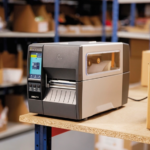How to choose your barcode printer?
Are you looking for a new barcode printer and find yourself confronted with a variety of options? Between size, print quality, and type of adhesion, the cost varies greatly from one option to another.
Your choice also depends on the desired application, and therefore the type of labels you print.
You also need to consider the printing volume and your working environment. For example, an industrial environment does not require the same type of printer as an office. Here are some tips to help you choose your barcode label printer. If in doubt, feel free to ask us any questions.
Two barcode printer technologies for different durability levels
The market compromises of thermal barcode label printers known as “direct” thermal printers and thermal transfer printers.
Direct thermal printers apply heat to the label to create the print. This is an easy-to-use and cost-effective technology. However, direct thermal label printers have a shorter lifespan than thermal printers. They are primarily intended for sectors that use their barcodes in low volumes, such as the food industry.
Barcode label printers, known as thermal transfer printers, apply heat to an ink ribbon and then transfer the ink from it to the label. This technology ensures a more durable print that is resistant to light and heat. These are generally industrial barcode printers, reserved for large volumes. These are traditionally used within manufacturing, distribution and supply chain.
Mobile or industrial barcode label printers
When choosing your barcode printer, the question of mobility often arises. Portable barcode printers, like the Zebra QLN420, are designed for mobile use. These models are both lightweight and compact. Easy to transport, these printers are used in various environments, from retail to healthcare.
Industrial barcode printers, like the Zebra ZT410, cover more intensive activity. These are fixed printers. Larger in size, they are also more robust and durable. These printers are better at withstanding dust, humidity or heat
Industrial barcode printers also print at a higher rate than portable barcode printers. Industrial printers print significant volumes of barcodes over short periods. They are traditionally dedicated to manufacturing, distribution, and supply chain sectors.
Choosing the printer based on how you apply the label
A company that applies its barcodes “by hand” can use either portable printers or so-called “desktop” printers (such as the Zebra GX420D or ZD420), intended for low print volumes. However, other barcode application methods require specific models.
Indeed, if you handle large volumes, you cannot be satisfied with sheet printers, for example. In this case, you will opt for a so-called “automatic dispense” printer or a printer equipped with a rewinder.
If you need to print a large volume of labels, choose a barcode printer with an automatic cutting function.
Convenience and print quality of your barcode printer
Also, consider the connectivity you need for your printer. Do you want to connect it to a computer? Your printer must therefore have USB connectivity.
If you prefer a wireless connection, some portable models also work with Wi-Fi or Bluetooth.
Finally, the various barcode printers on the market display varying print resolution levels. This resolution is expressed in “dpi”, “Dots Per Inch”, or simply according to the total number of horizontal and vertical pixels. In other words, the printer’s resolution refers to the number of points it can align over a given length. This generally ranges from 200 to 600 dpi for barcode printers. For quality printing, aim for high resolution levels.
The cost criteria when choosing a barcode printer
Once you have chosen your printer category, consider all purchasing options. New ones are often attractive, as there are no durability concerns. However, refurbished barcode printers have many advantages:
- Affordable, they are much more cost effective to buy compared to new printers.
- Quality-wise, they are machines completely refurbished by experts. They are therefore also covered by warranties.
- Performance-wise, these barcode printers remain as productive as new ones.
- Providers offering a wide range of refurbished printers give you the opportunity to maintain a uniform estate of your IT hardware.
Note that buying refurbished differs from buying used. Although cheaper, used printers do not benefit from the typical refurbishment process practiced by Codeo.
We also advise you to distinguish between the purchase cost and the operating cost. Depending on the printing speed, yield, and ink consumption, the cost per print varies greatly. Therefore, consider the price of print heads, label ribbons, stickers and/or rolls, etc. Your printer consumables should allow you to control operating costs in the long run.
Getting guidance in your printer purchase
Every business is unique, and your needs may require thorough analysis. Codeo offers a wide range of barcode printers, as well as repair and maintenance services.
Depending on your expectations in terms of quality, connectivity, label adhesion, durability, resolution, printing costs, speed, label width, etc., our recommendations become clearer. We also take into account your working environment: industrial, office, or warehouse.
We offer a wide range of barcode printers from the most well-known brands in the field, such as Zebra, Intermec, Datamax, Sato, and Honeywell.
I want assistance for my barcode printer (link to contact form)




